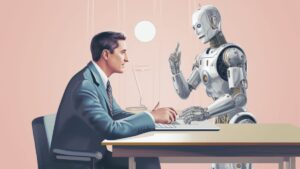
The latest federal decision in the relationship between art and artificial intelligence came down Friday. A federal judge ruled that visual art created by a computer system without human assistance could not be copyrighted, upholding a previous decision by the U.S. Copyright Office.
“Defendants are correct that human authorship is an essential part of a valid copyright claim, and therefore plaintiff’s pending motion for summary judgment is denied,” the decision reads. Instead, summary judgment was granted to the Copyright Office and Shira Perlmutter, its director.
Questions around AI art have been core to the ongoing Hollywood strikes for both the WGA and SAG-AFTRA. Writers have sought protections from studios using AI to create scripts, while actors want to be protected from having their performances used in ways that could potentially include replacing human actors.
In the AI court case mentioned above, Stephen Thaler had tried copyrighting a piece of art created by Thaler’s “Creativity Machine” artificial intelligence system in November 2018. The piece is titled “A Recent Entrance to Paradise.”
Thaler argued that, as owner of the computer, the copyright should transfer to him. But the copyright was denied in August 2019 because the image “lacks the human authorship necessary to support a copyright claim,” the government’s copyright examiner said in their original decision.
“Copyright has never stretched so far, however, as to protect works generated by new forms of technology operating absent any guiding human hand, as plaintiff urges here. Human authorship is a bedrock requirement of copyright,” Friday’s ruling reads.
The decision notes that the question remains of where the line is when it comes to how much human input is needed for copyright to exist.
“Undoubtedly, we are approaching new frontiers in copyright as artists put AI in their toolbox to be used in the generation of new visual and other artistic works,” the decision reads. “The increased attenuation of human creativity from the actual generation of the final work will prompt challenging questions regarding how much human input is necessary to qualify the user of an AI system as an ‘author’ of a generated work, the scope of the protection obtained over the resultant image, how to assess the originality of AI-generated works where the systems may have been trained on unknown pre-existing works, how copyright might best be used to incentivize creative works involving AI, and more.”
But, at least in this case, the complete lack of human input into the creation led to the decision that no copyright was available here.















